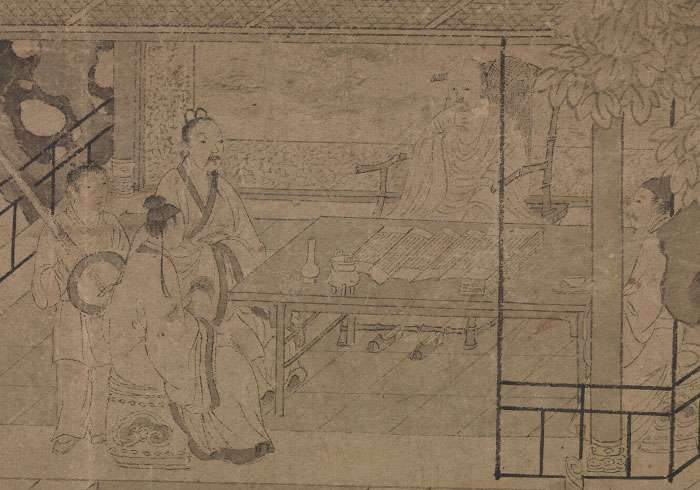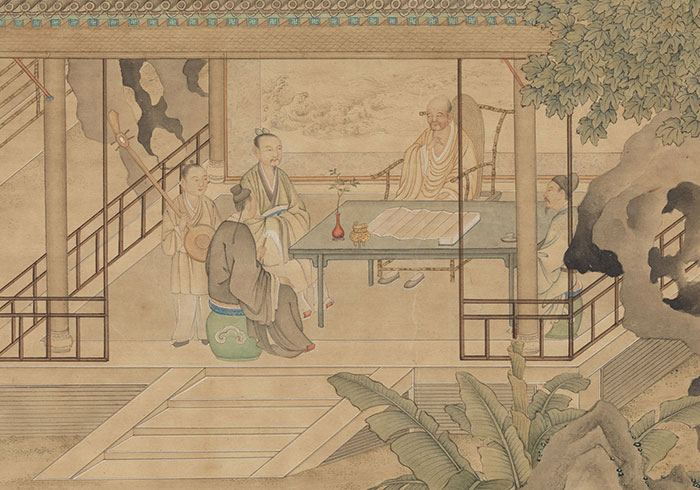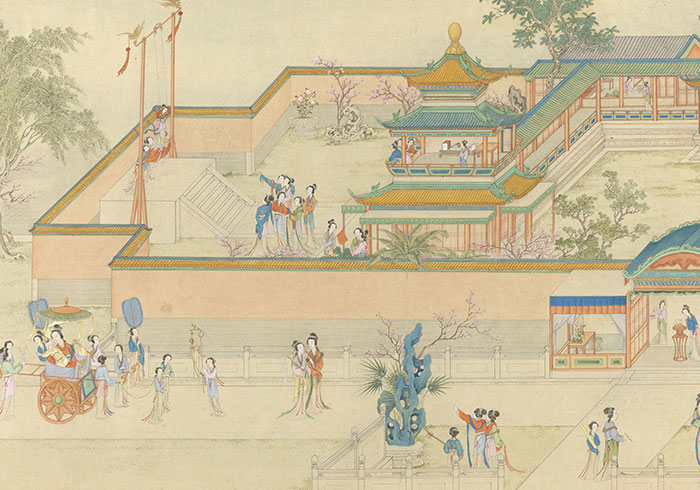The commercial art products of Suzhou that imitated antiquity, with their bright colors and vivid details, were not only popular among different levels of society in the Jiangnan region, they were even presented as tribute by nobility and officials to the Qing dynasty emperors. But did the Qing emperors know that these works were actually "fineries of forgery"? Or did they see them as precious traces from the ancient past? Regardless of the answer, the Kangxi, Yongzheng, and Qianlong emperors did indeed highly appreciate Qiu Ying's style of painting and the manner of Suzhou imitations of antiquity influenced by Qiu's archaism. In fact, the Qing court learned much about the themes and compositions of "antiquity" through these Suzhou fakes. For example, the Kangxi emperor ordered court painters to make a copy of the Suzhou fake for "Spring Dawn in the Han Palace," and the Yongzheng emperor told artists to copy "Up the River on Qingming." And by the Qianlong reign, not only were there even more copies of popular Suzhou fakes to be found, their motifs and styles were employed in court painting projects of various subjects, including "Activities of the Twelve Months." These works, prefixed in their titles with such terms as "academy version" or "painting academy," testify to how "fineries of forgery" related to Suzhou fakes became an important source behind the painting style of the High Qing court.
Elegant Gathering in the Western Garden
- Attributed to Qiu Ying (ca. 1494-1552), Ming dynasty
- Hanging scroll, ink on silk, 79 x 38.9 cm
"Elegant Gathering in the Western Garden" was reportedly a major meeting of literati held at the Western Garden of the imperial son-in-law Wang Shen (ca. 1046-after 1100). Legend has it that fifteen prominent members of Northern Song cultural circles, such as Su Shi, Li Gonglin, and Mi Fu, were in attendance. The painting done afterwards is generally given to Li Gonglin (ca. 1041-1106) and the record to Mi Fu (1052-1107), but research indicates that the text actually did not appear until the Ming dynasty (1368-1644). Therefore, both the text and painting are later fabrications.
Although this monochrome ink painting is attributed to Qiu Ying, the style is dissimilar from his other accepted works; it is probably a "Suzhou fake." The Qianlong emperor (1711-1799) in the Qing dynasty, however, attached great significance to the painting, not only having a piece of paper inscribed with his characters for "Superb Viewing" mounted at the top, but also inscribing it with the following: "Among paintings after the manner of Li (Gonglin), colors must be added to achieve formal likeness." This is because the fabricated "Record on the Painting of 'Elegant Gathering in the Western Garden'" states, "Li Boshi (Gonglin) followed Lesser General Li (Zhaodao) of the Tang by adding colors to rocks and streams." Thus, the Qianlong emperor believed that if Qiu Ying had desired to imitate the original Li Gonglin, he should have added colors to achieve "formal likeness."
Copy of Qiu Ying's "Elegant Gathering in the Western Garden"
- Ding Guanpeng (ca. 1708-1771 or afterwards), Qing dynasty
- Hanging scroll, ink and colors on silk, 95.1 x 43.9 cm
Ding Guanpeng produced a large number of works patterned after antiquity for the Qianlong emperor. However, many of the paintings he imitated have now been identified as professional forgeries of the Ming dynasty, as seen in the case here. The original upon which this hanging scroll is based can be found in the National Palace Museum collection. That work, done in the "baimiao" manner of ink painting is, judging from the slender and elongated forms, close to the style of You Qiu (fl. 16th c.), the son-in-law of Qiu Ying. Among "Suzhou fakes," this type of "baimiao" painting is often attributed to Qiu Ying. The Qianlong emperor in his poetry inscribed on the original about the coloring and formal likeness, which became points to be emulated in this copy.
Ding Guanpeng's version retains the composition of the prototype, but the application of colors to the figures, furniture, and plants gives it a light elegance similar to the Wu School manner for a shimmering quality. Furthermore, the structure of the pavilion roof and columns as well as the lake rocks show the texturing and shading found in Western drawing. The work as a whole can thus be considered an amalgamation of the Suzhou professional "baimiao" style, Wu School manner, and imported Western painting techniques.
Imitation of Qiu Ying's "Spring Dawn in the Han Palace"
- Ding Guanpeng (ca. 1708-1771 or afterwards), Qing dynasty
- Handscroll, ink and colors on silk, 34.5 x 675.4 cm
Ding Guanpeng, a native of Shuntian (modern Beijing), learned painting from the Italian artist Giuseppe Castiglione (1688-1766) at the Qing court and was admired by the Qianlong emperor. He was often commissioned to do paintings "in imitation of antiquity," this work serving as an example of such. The subject of "Spring Dawn in the Han Palace" appears to be an old one but actually is an innovation of the Ming dynasty that was highly appreciated at the Qianlong court. In fact, the court produced at least four versions of "Spring Dawn in the Han Palace," of which three are prefixed in their titles as "academy version," or official.
The prototype for this handscroll is most likely the "baimiao" ink version of "Spring Dawn in the Han Palace" now in the Liaoning Provincial Museum, a popular product of Suzhou professional workshops often spuriously given to Li Gonglin (ca. 1041-1106) of the Song dynasty or Qiu Ying (ca. 1494-1552). Based on archives from the Qing imperial workshops, when the Qianlong emperor ordered Ding Guanpeng to make this copy, Ding was instructed to add light colors to the "baimiao" painting. The work indeed has elegantly light colors overall and is also filled with numerous examples of exotic architecture and furnishings, making "antiquity" an ideal place for the imagination to roam.



